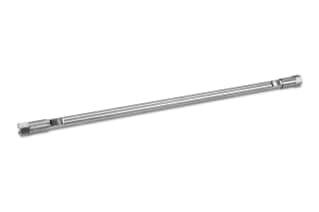
|
Chemistry |
Silica |
|
Separation Mode |
Normal-Phase |
|
Particle Substrate |
Silica |
|
pH Range Min |
2 pH |
|
pH Range Max |
8 pH |
|
Temperature Limits |
45 C |
|
Maximum Pressure |
6000 psi (415 Bar) |
|
Endcapped |
No |
|
Bonding Technology |
Silica |
|
Silanol Activity |
High |
|
Particle Shape |
Spherical |
|
Particle Size |
5 µm |
|
Endfitting Type |
Waters |
|
Pore Size |
100 Å |
|
Format |
Column |
|
Surface Area |
340 |
|
System |
HPLC |
|
Technique |
LC/MS, LC |
|
USP Classification |
L3 |
|
Inner Diameter |
4.6 mm |
|
Length |
250 mm |
|
UNSPSC |
41115709 |
|
Brand |
SunFire |
|
Product Type |
Columns |
|
Units per Package |
1 pk |

SunFire Silica Prep Column, 100Å, 5 µm, 4.6 mm X 250 mm, 1/pk
SunFire Columns are considered to be among the most superior bonded Silica HPLC Columns available, having been developed after extensive research and development. SunFire Columns offer the pinnacle of particulate and bonding expertise, delivering the greatest levels of chromatographic performance in the industry.
SunFire Columns have outstanding column lifetimes that outlast several traditional silica-based HPLC column brands in ultra-low pH mobile-phase settings. At low and moderate pH ranges, SunFire Columns provide symmetrical peaks for improved resolution of acidic, neutral, and basic compounds. SunFire Silica Prep Columns, when combined with effective SunFire Particles, reduce the need for time-consuming technique re-optimization. Because of the column's outstanding resolution, speed, and minimal back-pressure, you save money and time during analysis.
The selection of a repeatable HPLC column is critical for developing novel analytical procedures for the latest pharmaceutical and biopharmaceutical products. Over the life of the method and the new medicinal product, the chosen column must produce the same chromatographic results. Over the years, SunFire columns have exhibited superior reproducibility and thus make an essential piece of lab equipment to have in your laboratory.
You can browse through our brochure or check out our website to review the complete collection of Waters products and find various products that are compatible with the SunFire Silica Prep Column. The website enables you to shop for lab equipment, as well as to reach out with any queries you may have.
You may also like reviewing the SunFire Silica Prep Guard Cartridge, 100Å, 5 µm, 19 mm X 10 mm, 1/pk; SunFire columns represent a new era in HPLC column performance and technology. The state-of-the-art reversed-phase C18 and C8 bonded silica delivers excellent peak shape, high efficiency, low MS bleed, and excellent low pH stability, as well as high mass loading capability. SunFire columns are ideally suited for demanding HPLC applications where high-performance, reproducible and reliable columns are required. The Optimum Bed Density (OBD) designed preparative column performance coupled with the choice of C18, C8, and Normal-Phase Silica chemistries makes SunFire an excellent choice for successful analytical-to-lab scale purification.
What Are The Operating Limitations Of The SunFire Silica Prep Column?
The SunFire Silica Prep Column can operate easily between an extensive pH range of 2 to 8 and up to a maximum of 6000 psi (or 415 Bar) pressure. However, you should note that working at the extremes of pressures, pH, and/or temperatures will result in shorter column lifetimes.